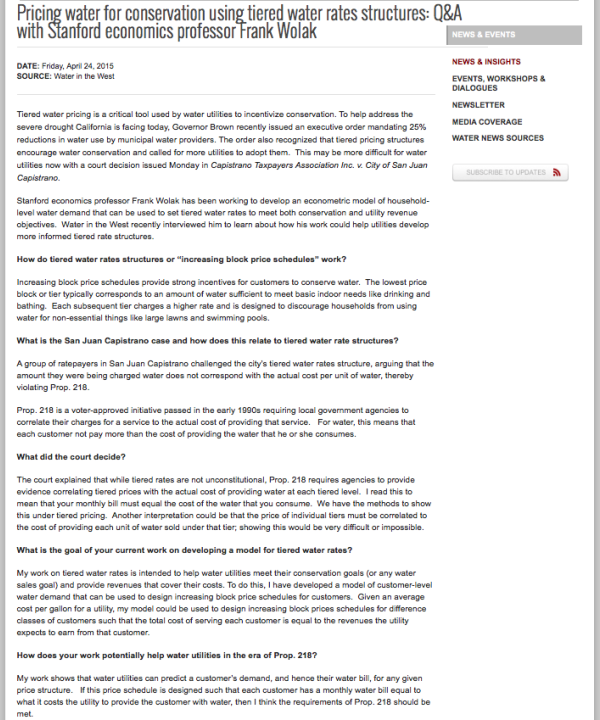April 24, 2015 | Water in the West | Insights
Tiered water pricing is a critical tool used by water utilities to incentivize conservation. To help address the severe drought California is facing today, Governor Brown recently issued an executive order mandating 25% reductions in water use by municipal water providers. The order also recognized that tiered pricing structures encourage water conservation and called for more utilities to adopt them. This may be more difficult for water utilities now with a court decision issued Monday in Capistrano Taxpayers Association Inc. v. City of San Juan Capistrano.
Stanford economics professor Frank Wolak has been working to develop an econometric model of household-level water demand that can be used to set tiered water rates to meet both conservation and utility revenue objectives. Water in the West recently interviewed him to learn about how his work could help utilities develop more informed tiered rate structures.
How do tiered water rates structures or “increasing block price schedules” work?
Increasing block price schedules provide strong incentives for customers to conserve water. The lowest price block or tier typically corresponds to an amount of water sufficient to meet basic indoor needs like drinking and bathing. Each subsequent tier charges a higher rate and is designed to discourage households from using water for non-essential things like large lawns and swimming pools.
What is the San Juan Capistrano case and how does this relate to tiered water rate structures?
A group of ratepayers in San Juan Capistrano challenged the city’s tiered water rates structure, arguing that the amount they were being charged water does not correspond with the actual cost per unit of water, thereby violating Prop. 218.
Prop. 218 is a voter-approved initiative passed in the early 1990s requiring local government agencies to correlate their charges for a service to the actual cost of providing that service. For water, this means that each customer not pay more than the cost of providing the water that he or she consumes.
What did the court decide?
The court explained that while tiered rates are not unconstitutional, Prop. 218 requires agencies to provide evidence correlating tiered prices with the actual cost of providing water at each tiered level. I read this to mean that your monthly bill must equal the cost of the water that you consume. We have the methods to show this under tiered pricing. Another interpretation could be that the price of individual tiers must be correlated to the cost of providing each unit of water sold under that tier; showing this would be very difficult or impossible.
What is the goal of your current work on developing a model for tiered water rates?
My work on tiered water rates is intended to help water utilities meet their conservation goals (or any water sales goal) and provide revenues that cover their costs. To do this, I have developed a model of customer-level water demand that can be used to design increasing block price schedules for customers. Given an average cost per gallon for a utility, my model could be used to design increasing block prices schedules for difference classes of customers such that the total cost of serving each customer is equal to the revenues the utility expects to earn from that customer.
How does your work potentially help water utilities in the era of Prop. 218?
My work shows that water utilities can predict a customer’s demand, and hence their water bill, for any given price structure. If this price schedule is designed such that each customer has a monthly water bill equal to what it costs the utility to provide the customer with water, then I think the requirements of Prop. 218 should be met.
A lot of water utilities are probably concerned about their tiered water rates structures at this point. What advice would you offer them?
Data and analytics will need to play a very big role for water utilities moving forward. Our research demonstrates that there are substantial economic benefits to knowing your customers. This recent court ruling provides even stronger incentive for utilities to take steps to do so. There’s plenty of low hanging fruit, such as online surveys, that can provide utilities with data that can feed into models like the one we’re developing to better estimate water consumption for any given price schedule. A utility’s rates can then be better correlated with cost of service to withstand challenges like this one.
Frank Wolak is the Holbrook Working Professor of Commodity Price Studies in Economics at Stanford University; Director of the Program on Energy and Sustainable Development; Senior Fellow by courtesy at the Stanford Institute for Economic Policy Research; and Senior Fellow at FSI for International Studies.


![[Woods Logo]](/sites/default/files/logos/footer-logo-woods.png)
![[Bill Lane Center Logo]](/sites/default/files/logos/footer-logo-billlane.png)